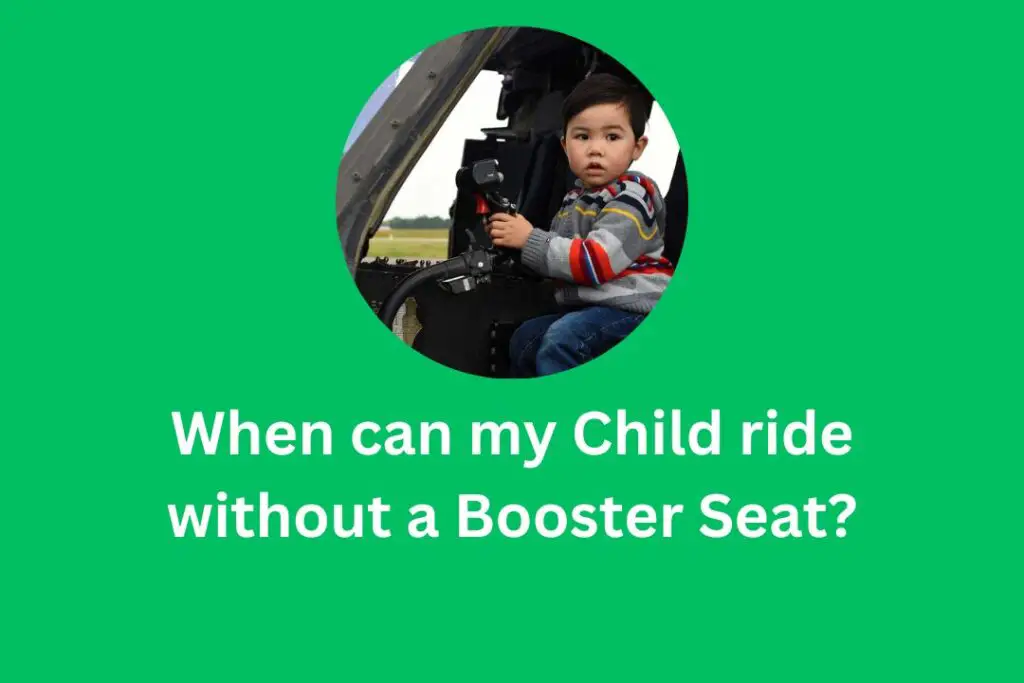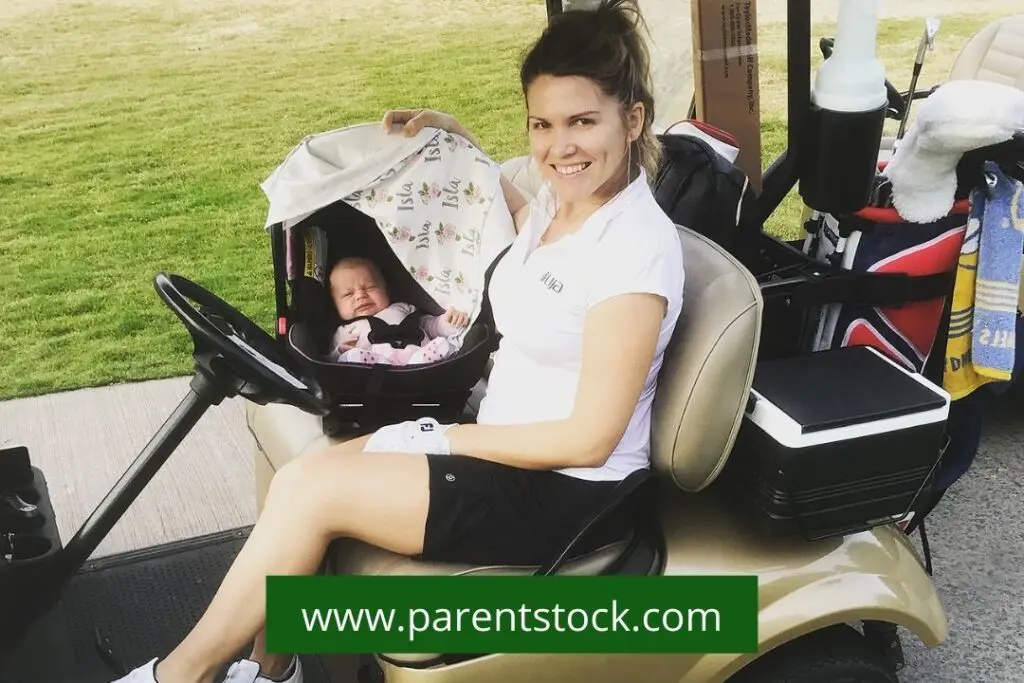As the sun rises, casting a warm golden glow over the horizon, the morning hustle and bustle begins. Imagine, parents fastening their children into their car seats, ensuring their safety as they travel to school or embark on family outings. A question burns in the minds of many parents: When can my Child ride without a Booster Seat? The answer is not as straightforward as one might expect, with different rules and regulations that vary from place to place.
Flickering in the rearview mirror, the sight of a child confined to a booster seat symbolizes a stage of growth and development. It’s a poignant reminder of the delicate period of childhood, where safety is paramount. Yet, there comes a time when the child outgrows this safety measure. The transition from booster seat to seat belt is a significant milestone, often fraught with confusion and doubt for parents. Unpicking the intricacies of when a child can ride without a booster seat is crucial. It requires understanding the laws and guidelines, as well as the child’s height, weight, and maturity level. The upcoming segments aim to shed light on these factors, bringing clarity and reassurance to all concerned parents.
Understanding the Law
Embarking on a journey of legalese, Understanding the Law unfurls the canvas of Booster Seat Laws by State. It paints vivid images of the age and height requirements, capturing the unique blend of rules across states. The journey takes an intriguing twist, exploring the Exceptions to the Law. It captures the grey areas, exceptions that break the norm. Finally, it reaches the heart of the narrative – Legal Rights and Responsibilities of Parents. This chapter unravels the legal tapestry that binds parents, their rights, and responsibilities, in the realm of booster seat laws.
Booster Seat Laws by State
Shifting gears, let’s zoom in on the Booster Seat Laws by State. Every state has its unique laws when it comes to children’s safety in vehicles. Picture this: In sunny California, for instance, children under the age of 8 must be secured in a car seat or booster in the vehicle’s back seat. Meanwhile, the crisp air of New York requires children under the age of 4 to ride in a federally approved car seat.
Hold on, there’s more: The Lone Star State, Texas, mandates that children younger than 8 years old, unless taller than 4’9″, must be in a car seat. Each state’s regulations vary in age, height, and weight requirements, painting a colorful mosaic of rules and regulations across the United States map.
And guess what? Even within a state, the laws may change over time, just like the vibrant fall leaves in Vermont. It’s crucial for parents to stay updated with the most recent laws to ensure their child’s safety and avoid any potential legal issues. Knowledge of these laws isn’t just about compliance; it’s about safeguarding the most precious cargo – our children.
Age and Height Requirements
With a bounce in our step, let’s delve into the Age and Height Requirements.
Ever wondered why Goldilocks found Papa Bear’s chair too big and Baby Bear’s chair just right? Well, this fairy tale logic applies to booster seats too. Picture this – a tiny tot, barely able to peek over the dashboard, nestled in a seat designed for a full-grown adult. That’s a recipe for disaster, isn’t it?
Now, imagine the same child, comfortably resting in a seat tailored to their needs. A sight of relief! In comes the law, stepping in like a superhero, setting the stage for safety and comfort.
Guidelines across states, generally advocate for children under the age of 8, or under a height of 4 feet 9 inches, to ride in a booster seat. These requirements, though varying slightly from state to state, are designed to ensure maximum safety for the child. Think of these requirements as the magic spell that transforms each car ride into a safe haven for your precious cargo.
Remember, these rules aren’t arbitrary; they are based on numerous safety studies and crash simulations. So, the next time you buckle up your child, remember the Goldilocks principle – it’s all about finding the perfect fit.
Exceptions to the Law
Imagine this: You’re planning a road trip with your little one. You’ve checked the booster seat laws in your state, and you’ve made sure the booster seat fits your child’s age and height requirements. But wait, there’s more to consider.
Indeed, exceptions to the law exist and it’s important to be aware of them. For instance, in some states, a child may be exempted from using a booster seat if they have a medical condition or physical disability that makes it impractical or unsafe. In other instances, exceptions may apply when a child is being transported in an emergency situation.
Furthermore, consider this: Certain vehicles, such as taxis or vehicles manufactured without safety belts, may also be exempt from these laws. It is important to note that these exceptions vary by state, so it’s crucial to research and understand the specific laws in your area.
Remember, it isn’t just about following the rules. It’s about ensuring the safety and well-being of your child. That’s why knowing the ins and outs of these laws, including the exceptions, can make your road trip not just a fun adventure, but a safe one too. Isn’t that something to look forward to?
Choosing the Right Seat
Navigating through the Different Types of Booster Seats can feel overwhelming, but worry not! A gentle understanding of their features ensures the best choice. Next, the Proper Installation is crucial. It’s like keeping the foundation of a building strong. Then comes the role of Seat Belt Positioning, a silent guard ensuring optimum safety. Remember, the height of the child is paramount, so Considering Child’s Height can’t be overlooked. Lastly, Fitting the Harness Properly is just like fastening the last button of a coat, securing everything together. Let’s delve into these facets of ‘Choosing the Right Seat’.
Different Types of Booster Seats
Looking at it from a different angle, knowing the law is just the first step on the journey of car safety. Now, let’s delve into the world of booster seats.
Imagine a candy store with a plethora of sweets to choose from. The same goes for booster seats, a perfect blend of variety and purpose, each type tailored to cater to a child’s unique needs. High back booster seats, with their towering forms, offer additional neck and head support. A perfect companion for cars that lack headrests.
On the other hand, backless booster seats are compact, easily portable, and ideal for older children who have outgrown their harnessed car seats but still need that little boost.
Further, combination seats offer a two-in-one solution. Starting as a harnessed car seat, they can be transformed into a booster seat as the child grows.
A rainbow of choices, isn’t it? But remember, the most colorful candy isn’t always the sweetest. What matters is choosing the right seat that fits the child’s age, weight, and height, and also fits well in the car.
In the end, it’s more than just a seat. It’s a commitment to safety, designed with love and care for the little ones.
Proper Installation
Moving beyond the legalities, let’s dive into the practicalities of ensuring your child’s safety while on the road. Picture this: a bustling Saturday morning, the sun dancing on the windscreen, the car parked in the driveway, and an uninstalled booster seat waiting for its moment.
Here, focus sharpens on Proper Installation. The booster seat, akin to a throne for your little one, requires careful placement. Imagine the seat as a puzzle piece, each contour and belt designed to fit perfectly into the car’s canvas. With meticulousness and precision, arrange it so it rests evenly against the car seat, its back flush with the vehicle’s backrest.
The seat’s tether strap, a vital actor in this performance, should be fastened securely to the designated anchor point. A gentle tug should reveal no movement. Envision a firm handshake – that’s the level of grip sought between seat and anchor.
The seat belt, the final security check, should be drawn across, its path unobstructed. It needs to run smoothly through the belt guide, the locking mechanism clicking into place with a satisfying snap.
In the end, the booster seat’s stability becomes an unspoken promise of safety, a testament to the care taken in its installation.
Seat Belt Positioning
“Ready to dive into the specifics?” Let’s plunge into the ocean of knowledge about Seat Belt Positioning.
Imagine gliding through a serene, safe journey, with the seatbelt snugly in place, providing a cocoon of protection. That’s the feeling of correctly positioned seat belts. It’s like a lifeline, a silent bodyguard, always at the ready.
Visualize this. The lower belt should lie flat across the upper thighs, not the stomach. It should feel like a gentle hug from a friend, firm yet comfortable. Meanwhile, the upper belt should run across the chest and shoulder, not the neck or face; think of it as a reassuring pat on the back.
Remember, a wrongly positioned seatbelt is like a ticking time bomb, dangerous and unpredictable. But hold on, you’re not alone in this journey. By following these guidelines, the journey becomes safer and more enjoyable.
Marvel at the beauty of a well-positioned seatbelt. It’s more than just a strip of fabric. It’s a shield, a guard, a friend on every journey. Embrace it, appreciate it, and most importantly, ensure it’s positioned correctly. After all, safety is the most significant milestone on any journey.
Assessing Your Child
Navigating the journey of your child’s growth involves crucial milestones, such as When to Transition to a Booster Seat. This step prompts a delightful growth spurt, but also necessitates understanding the Right Time to Remove the Booster Seat. Each child’s development varies, hence the significance of Height and Weight Requirements. Embedding the importance of Understanding Safety Rules ensures a secure environment. Lastly, the Child’s Age acts as a compass, guiding these transitions. The path of your child’s development can indeed be a beautiful adventure.
When to Transition to a Booster Seat
Just as the right seat is critical, understanding when to transition to a booster seat is equally essential.
Now, imagine a journey where the little ones are seated securely, their eyes wide with excitement, as the world outside the window reveals its wonders. This enchanting scenario, however, hinges on knowing when to switch from a car seat to a booster seat.
Believe it or not, age is not always the best indicator for this transition. Instead, the child’s size and maturity level play a vital role.
Picture a child, seated comfortably, knees bent at the seat’s edge, and the shoulder belt fitting snugly across the chest – not the neck or face. The lap belt, meanwhile, rests on the thighs, not the stomach. These are the signs that your child is ready for a booster seat.
Keep in mind, the transition is not a race. Children grow at different rates, and what might be right for one may not be the best for another.
So next time, before setting off on that magical journey, make sure the booster seat transition is appropriately timed. It’s all about ensuring a safe and enjoyable ride for the little adventurers.
The Right Time to Remove the Booster Seat
Just as settling on the right seat for your child can be a challenge, knowing when to transition away from the booster seat can bring equally troubling dilemmas. So, let’s address this issue – The Right Time to Remove the Booster Seat.
Engage the imagination and picture this – a little one, all grown-up and ready to sit in the car just like the adults. But, before getting carried away with this exciting milestone, ensure that the child fits within the height and weight parameters set by safety regulations.
Observe the child’s posture when seated without the booster seat. If the knees bend comfortably at the edge of the seat and the feet touch the floor, it might be time to bid the booster seat goodbye. There’s also the seatbelt to consider. If the lap belt fits snugly across the upper thighs, not the stomach, and the shoulder belt lies across the chest, not the neck or face, then perhaps the booster seat has fulfilled its purpose.
Remember, just as the sunflower must reach a certain growth stage before blooming, your child must meet certain safety requirements before moving on from the booster seat. A premature shift could compromise their safety, so make this transition with care and caution.
Height and Weight Requirements
Just like finding the perfect seat at a dinner table, ensuring the safety of a child in a vehicle is of utmost importance. Now, imagine this. The sun is shining, the birds are chirping, and it’s time to consider the height and weight requirements of a child for seat transitioning.
The numbers are essential, of course, but they also serve as a reminder of growth. Let’s dive in. The transition to a booster seat should occur when a child has outgrown their forward-facing seat, typically around 40 pounds. The specific weight can vary, so always refer to the manufacturer’s guidelines.
Does this sound complicated? Well, don’t worry! Remember, it’s all about ensuring safety while growing up. Now, for the magic number for removing that booster seat. It’s usually when the child reaches about 80-100 pounds. But listen up! This is not just about weight. The child’s height plays an influential role too. A height of 4’9” is the generally accepted guideline.
Think of it as a milestone in the journey of growing up, a signal that your child is becoming a big kid now. Remember, each child grows at their own pace, so don’t rush these transitions. It’s all about safety, growth, and embracing the journey.
Other Safety Considerations
Venturing into the realm of Other Safety Considerations, an exploration of Vehicle Safety Features unfolds. This journey includes vehicle enhancements such as airbags and anti-lock braking systems. Next, attention shifts to the Other Occupants in the Vehicle and their role in safety maintenance. Subsequently, the focus narrows on the importance of a Proper Seat Belt Fit, ensuring secure and comfortable restraint. A leap is then made back to Vehicle Safety Features, reinforcing their indispensable role. Lastly, the intricate balance of a Child’s Physical and Behavioral Maturity is highlighted, underlining the importance of age-appropriate restraints and behavior.
Vehicle Safety Features
Moving on from an assessment of a child’s unique needs, let’s now turn our attention to the invaluable role of vehicle safety features in ensuring a safe journey.
Imagine a fortress on wheels – that’s what the modern vehicle aims to be, with an array of safety features designed to protect its precious cargo. Airbags, those silent sentinels, wait patiently, ready to cushion the blow in the unfortunate event of a collision. Seat belts, those unsung heroes, stand guard, hugging passengers close, while the anti-lock braking system diligently keeps the vehicle from skidding out of control.
A special mention must be made of electronic stability control, a sophisticated system that detects and reduces loss of traction, mitigating the risk of a dangerous spin. And then there’s the rearview camera; those digital eyes helping drivers navigate tricky backing situations, keeping the path clear of unexpected obstacles.
All these features, and many more, work in harmony to create a safe environment within the vehicle. However, their effectiveness depends largely on proper usage and regular maintenance. Remember, these technological marvels are not just fancy add-ons, but crucial tools in the quest for safety.
Other Occupants in the Vehicle
Leaping from the topic of your cherished one’s capacities, now imagine a bustling vehicle full of laughter and chatter. Other occupants in the vehicle can influence the safety of the journey just as much as the driver.
Isn’t it fascinating? The vehicle, a small universe on wheels, pulsates with life. Giggles echo, conversations intertwine, and the radio hums a merry tune. Yet amidst this symphony of sound, safety holds the baton. Every passenger, from the front seat companion to the back-row chatterbox, plays a key role in preserving this harmony.
Picture this: An older sibling, engrossed in their handheld game, oblivious to their younger sister’s attempts to unbuckle her seatbelt. Now imagine the same scene, but this time, the older sibling notices and gently reminds their sister of the importance of staying buckled up. The vehicle continues to hum along, its precious cargo secure.
Here’s the thing, the responsibility of safety doesn’t solely rest on the driver’s shoulders. It’s a shared responsibility, a community effort within the confines of the vehicle. So, as the journey continues, let the laughter ring and the conversations flow, but always keep a watchful eye on safety.
Proper Seat Belt Fit
Just imagine the feeling of relief, knowing your child is safely buckled up. Now, let’s talk about Proper Seat Belt Fit.
One of the crucial elements in vehicle safety is the correct fit of the seat belt. The lap belt should sit low and snug across the upper thighs, not the stomach. The shoulder belt should lie comfortably across the chest and shoulder, not crossing the neck or face. Isn’t that interesting?
And guess what? The seat belt should never be tucked under the arm or behind the back. It’s essential for the belt to be worn correctly to provide optimal protection. Does that make sense?
And here’s the clincher: Always double-check the seat belt fit. Make sure it is tight enough to hold the child securely, but not so tight as to cause discomfort.
Remember, a properly fitted seat belt can be a lifesaver. Its primary role is to keep occupants from being ejected during a collision and to reduce the risk of contact with the vehicle’s interior.
So, take a few moments to ensure the seat belt fits correctly. It’s a small step that can make a big difference!
Additional Resources
Delve into the world of Understanding Car Seat Ratings and discover what makes a car seat commendable. Familiarize yourself with Car Seat Safety Guidelines to ensure the utmost protection for your little one. Stay vigilant with Car Seat Recalls, a crucial resource for any potential safety risks. Seek wisdom from Pediatricians’ advice, trusted experts who prioritize a child’s well-being. Lastly, gain insight from Safety statistics, empirical data that fortifies our understanding and helps make informed decisions. Embrace these resources, paving the way for a safe and enjoyable journey with your child.
Understanding Car Seat Ratings
And now, let’s shift gears to a pivotal aspect of car seat safety – Understanding Car Seat Ratings.
Imagine walking into a store, eyes scanning over rows upon rows of car seats. Each one with a different design, price, and most importantly, a different safety rating. It’s a jungle out there, but understanding car seat ratings can be the compass to navigate it.
The National Highway Traffic Safety Administration (NHTSA) provides a 5-star rating system for car seats. Think of it as a report card for car seat safety. The stars represent ease of use, clarity of instructions, and vehicle installation features. A 5-star rating indicates an excellent grade, meaning the car seat is easy to install and use, and the instructions are crystal clear.
Not all car seats are created equal, and that’s why the NHTSA ratings are so crucial. And remember, a higher price tag doesn’t always equate to a higher safety rating. So, when shopping for a car seat, make sure to look at the stars, not just the price tag.
In the world of car seat safety, knowledge is power. And understanding these ratings is the first step in making an informed decision.
Car Seat Safety Guidelines
Imagine this: A family embarking on a road trip, confident in the safety of their child nestled securely in a car seat. This is exactly what following car seat safety guidelines can achieve.
First off, one should always refer to the car seat manufacturer’s instructions, the first resource in the labyrinth of car seat safety. These guidelines typically provide detailed instructions on installation and usage, tailor-made for the specific model.
Then we have the position of the car seat. For infants and toddlers, a rear-facing car seat in the back seat is the golden rule. As the child grows, transition to a forward-facing car seat, and eventually to a booster seat, maintaining the placement in the back seat until the age of 13.
In this world of child safety, the use of the harness is paramount. A snug-fitting harness is a child’s lifeline in case of a crash. It should lie flat without any twists, with the chest clip at armpit level.
And don’t forget: regular checks are key. As children grow like weeds, adjustments to the car seat become necessary, ensuring a snug and safe fit at all times.
Buckle up and embrace the journey, the safest possible journey, thanks to these easy-to-follow car seat safety guidelines.
Car Seat Recalls
Imagine driving down a picturesque country road, the sun setting behind the mountains, and the little ones in the back seat, safely buckled into their car seats. Yet, what if the safety of those car seats came under question? Just imagine how important it is to stay updated about car seat recalls.
Safety should never take a backseat, and it’s no different when it comes to children’s car seats. Believe it or not, manufacturers do recall car seats from the market when they find flaws that could jeopardize your child’s safety. The slightest defect could make all the difference, and it’s always better to be safe than sorry.
Now, picture this – a dedicated and easy-to-navigate website where all recent car seat recalls are listed. There, in plain sight, are the make, model, and the reason for the recall, ensuring that parents can cross-check their child’s car seat. And yes, this isn’t a fantasy. Websites like the National Highway Traffic Safety Administration (NHTSA) regularly update such lists.
Remember this, a recalled car seat isn’t a sentence of doom. Manufacturers often offer free repair kits or replacements. Staying informed and proactive keeps the journey safe, and the sunset drives worry-free.
Conclusion
In the journey of parenting, the question, “When can my Child ride without a Booster Seat?” marks an important milestone. It is a blend of understanding the law, selecting the appropriate seat, assessing your child’s readiness, and considering other safety aspects.
In conclusion, keeping abreast with additional resources and staying updated with child safety norms will ensure a smooth, safe, and enjoyable ride. A little precaution today will ensure a future filled with many joyous, trouble-free road trips with your growing child.





